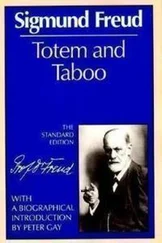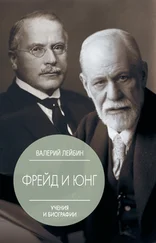In Latin there are still such words of double meaning:
altus —high, deep, and sacer , sacred, accursed.
As examples of modifications of the same root, I cite:
clamare —to scream, clam —quiet, still, secret;
siccus —dry, succus —juice.
And from the German:
Stimme —voice, stumm —dumb.
The comparison of related tongues yields a wealth of examples:
English: lock ; German: Loch —hole, Lücke —gap.
English: cleave ; German: kleben —to stick, to adhere.
The English without , is to–day used to mean "not with"; that "with" had the connotation of deprivation as well as that of apportioning, is apparent from the compounds: withdraw , withhold . The German wieder , again, closely resembles this.
Another peculiarity of dream–work finds it prototype in the development of language. It occurred in ancient Egyptian as well as in other later languages that the sequence of sounds of the words was transposed to denote the same fundamental idea. The following are examples from English and German:
Topf — pot ; boat — tub ; hurry — Ruhe (rest, quiet).
Balken (beam)— Kloben (mallet)— club .
From the Latin and the German:
capere (to seize)— packen (to seize, to grasp).
Inversions such as occur here in the single word are effected in a very different way by the dream–work. We already know the inversion of the sense, substitution by the opposite. Besides there are inversions of situations, of relations between two people, and so in dreams we are in a sort of topsy–turvy world. In a dream it is frequently the rabbit that shoots the hunter. Further inversion occurs in the sequence of events, so that in the dream the cause is placed after the effect. It is like a performance in a third–rate theatre, where the hero falls before the shot which kills him is fired from the wings. Or there are dreams in which the whole sequence of the elements is inverted, so that in the interpretation one must take the last first, and the first last, in order to obtain a meaning. You will recall from our study of dream symbolism that to go or fall into the water means the same as to come out of it, namely, to give birth to, or to be born, and that mounting stairs or a ladder means the same as going down. The advantage that dream distortions may gain from such freedom of representation, is unmistakable.
These features of the dream–work may be called archaic . They are connected with ancient systems of expression, ancient languages and literatures, and involve the same difficulties which we shall deal with later in a critical connection.
Now for some other aspects of the matter. In the dream–work it is plainly a question of translating the latent thoughts, expressed in words, into psychic images, in the main, of a visual kind. Now our thoughts were developed from such psychic images; their first material and the steps which led up to them were psychic impressions, or to be more exact, the memory images of these psychic impressions. Only later were words attached to these and then combined into thoughts. The dream–work therefore puts the thoughts through a regressive treatment, that is, one that retraces the steps in their development. In this regression, all that has been added to the thoughts as a new contribution in the course of the development of the memory pictures must fall away.
This, then, is the dream–work. In view of the processes that we have discovered about it, our interest in the manifest dream was forced into the background. I shall, however, devote a few remarks to the latter, since it is after all the only thing that is positively known to us.
It is natural that the manifest dream should lose its importance for us. It must be a matter of indifference to us whether it is well composed or resolved into a series of disconnected single images. Even when its exterior seems to be significant, we know that it has been developed by means of dream distortion and may have as little organic connection with the inner content of the dream as the facade of an Italian church has with its structure and ground plan. At other times this facade of the dream, too, has its significance, in that it reproduces with little or no distortion an important part of the latent dream thought. But we cannot know this before we have put the dream through a process of interpretation and reached a decision as to what amount of distortion has taken place. A similar doubt prevails when two elements in the dream seem to have been brought into close relations to one another. This may be a valuable hint, suggesting that we may join together those manifest thoughts which correspond to the elements in the latent dream; yet at other times we are convinced that what belongs together in thought has been torn apart in the dream.
As a general rule we must refrain from trying to explain one part of the manifest dream by another, as if the dream were coherently conceived and pragmatically represented. At the most it is comparable to a Breccian stone, produced by the fusion of various minerals in such a way that the markings it shows are entirely different from those of the original mineral constituents. There is actually a part of the dream–work, the so–called secondary treatment , whose function it is to develop something unified, something approximately coherent from the final products of the dream–work. In so doing the material is often arranged in an entirely misleading sense and insertions are made wherever it seems necessary.
On the other hand, we must not over–estimate the dream–work, nor attribute too much to it. The processes which we have enumerated tell the full tale of its functioning; beyond condensing, displacing, representing plastically, and then subjecting the whole to a secondary treatment, it can do nothing. Whatever of judgment, of criticism, of surprise, and of deduction are to be found in the dream are not products of the dream–work and are only very seldom signs of afterthoughts about the dream, but are generally parts of the latent dream thought, which have passed over into the manifest dream, more or less modified and adapted to the context. In the matter of composing speeches, the dream–work can also do nothing. Except for a few examples, the speeches in the dream are imitations and combinations of speeches heard or made by oneself during the day, and which have been introduced into the latent thought, either as material or as stimuli for the dream. Neither can the dream pose problems; when these are found in the dream, they are in the main combinations of numbers, semblances of examples that are quite absurd or merely copies of problems in the latent dream thought. Under these conditions it is not surprising that the interest which has attached itself to the dream–work is soon deflected from it to the latent dream thoughts which are revealed in more or less distorted form in the manifest dream. It is not justifiable, however, to have this change go so far that in a theoretical consideration one regularly substitutes the latent dream thought for the dream itself, and maintains of the latter what can hold only for the former. It is odd that the results of psychoanalysis should be misused for such an exchange. "Dream" can mean nothing but the result of the dream–work, that is, the form into which the latent dream thoughts have been translated by the dream–work.
Dream–work is a process of a very peculiar sort, the like of which has hitherto not been discovered in psychic life. These condensations, displacements, regressive translations of thoughts into pictures, are new discoveries which richly repay our efforts in the field of psychoanalysis. You will realize from the parallel to the dream–work, what connections psychoanalytic studies will reveal with other fields, especially with the development of speech and thought. You can only surmise the further significance of these connections when you hear that the mechanism of the dream structure is the model for the origin of neurotic symptoms.
Читать дальше







